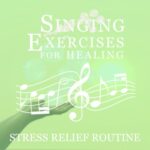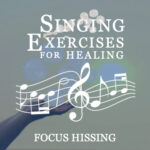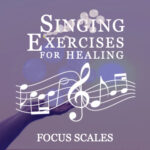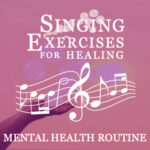Activities Details

Complete Series Of
Singing Activities
Hover over the card for instructions on how to use the activity!


Diaphragmatic Breathing
Diaphragmatic breathing, or “belly breathing,” involves using the diaphragm muscle located just below the lungs. This type of breathing is especially effective for reducing stress because it activates the parasympathetic nervous system, promoting relaxation.
Diaphragmatic breathing helps singers maintain a steady, powerful voice and provides a sense of calm that counteracts stress. Practicing this exercise before singing sets the stage for effective breath control and enhances the overall relaxation experience.
- How to Practice Diaphragmatic Breathing:
- Sit or stand with a straight back. Place one hand on your chest and the other on your abdomen.
- Inhale deeply through your nose, allowing your abdomen to expand while keeping your chest relatively still.
- Exhale slowly through your mouth, feeling your abdomen contract as you release the breath.
- Repeat this cycle 5–10 times, focusing on smooth, controlled breathing.

Box Breathing
Box breathing, also known as four-square breathing, is a technique that helps regulate the breath and calm the nervous system. This method can be used before singing to reduce anxiety and bring the mind into a focused, peaceful state.
Box breathing encourages mindfulness and enhances the singer’s control over their breath, making it easier to maintain steady vocalisation and calming the mind in preparation for singing.
How to Practice Box Breathing:
- Inhale slowly through your nose for a count of four.
- Hold your breath for a count of four.
- Exhale slowly through your mouth for a count of four.
- Hold your breath again for a count of four.
- Repeat this cycle four to five times.

Alternate Nostril Breathing
This yoga-inspired breathing technique balances the body’s energy and promotes mental clarity. Alternate nostril breathing can help singers focus, reduce stress, and achieve a sense of equilibrium before vocal exercises.
This technique balances both hemispheres of the brain, promotes focus, and reduces stress, making it ideal for singers who want to begin their practice with a calm and centred mindset.
How to Practice Alternate Nostril Breathing:
- Sit comfortably and close your right nostril with your right thumb.
- Inhale deeply through your left nostril.
- Close your left nostril with your ring finger and release your thumb from your right nostril.
- Exhale through your right nostril.
- Inhale through your right nostril, then close it and exhale through your left.
- Repeat this cycle for 1–2 minutes, focusing on balanced, steady breaths.

Humming Warm Up
Humming is a gentle way to activate the vocal cords and relieve tension in the throat and jaw. It also produces calming vibrations that resonate throughout the body, contributing to relaxation.
Humming warms up the vocal cords without straining them and can serve as a form of “vocal meditation.” The gentle vibrations help you connect to your breath and prepare the voice for further exercises.
How to Practice Humming:
- Begin with a comfortable, closed-mouth hum, focusing on keeping your throat relaxed.
- Experiment with gentle, slow scales or hum along to a simple tune.
- Pay attention to the vibrations in your face and chest, letting them relax you.

Lip Trill Warm Up
Lip trills are an effective warm-up exercise that engages breath control and helps release tension around the mouth and jaw. Lip trills allow for smooth airflow, making it easier to maintain a relaxed state while singing.
Lip trills help singers gain better control over their breath and vocal dynamics. This exercise can be particularly effective for reducing tension in the jaw and face, common areas where stress accumulates.
How to Practice Lip Trills:
- Take a deep breath, then gently press your lips together.
- Exhale with a light buzzing sound, allowing your lips to vibrate as the air flows out.
- Practice ascending and descending pitches, focusing on consistent breath flow and relaxed lips.

Siren Warm Up
Sirens are vocal slides that cover a range of pitches, allowing you to explore your vocal range while engaging the entire vocal mechanism. This exercise also promotes relaxation by releasing pent-up energy through vocalisation.
Sirens are excellent for relieving vocal tension and stretching the voice in a relaxed manner. By allowing the voice to “siren” through different pitches, you reduce mental and physical stress, setting up a relaxed and flexible vocal environment.
How to Practice Sirens:
- Begin with a low note and smoothly glide up to your highest comfortable pitch.
- Once you reach the top, slide back down to the starting pitch.
- Repeat this cycle several times, focusing on a smooth, controlled transition between pitches.

Muscle Relaxation
Progressive muscle relaxation involves systematically tensing and relaxing different muscle groups to release tension throughout the body. This technique helps singers identify and eliminate areas of physical stress, enhancing relaxation before singing.
By eliminating muscular tension, progressive muscle relaxation helps singers achieve better posture, breath control, and mental focus, all of which contribute to a relaxed singing experience.
How to Practice Progressive Muscle Relaxation:
- Sit or lie down comfortably and take a few deep breaths.
- Starting with your feet, tense the muscles for a few seconds, then release.
- Gradually work your way up through each muscle group (legs, abdomen, chest, shoulders, neck, and face), tensing and relaxing as you go.
- Focus on the sensation of release and relaxation in each area.

Visualisation
Visualisation can help reduce performance anxiety and create a positive mental state for singing. By visualising yourself singing confidently, you can foster a sense of calm and prepare mentally for singing.
Visualisation allows you to mentally rehearse relaxation, helping you build confidence and reduce stress when you begin singing.
How to Practice Visualisation:
- Close your eyes and take a few deep breaths.
- Visualise yourself in a calm, supportive environment where you feel safe to sing.
- Imagine yourself singing effortlessly, focusing on feelings of confidence, joy, and relaxation.
- Picture each note flowing smoothly, with your body relaxed and your mind at ease.

Body Scanning
Body scanning involves mentally scanning the body to identify areas of tension and release them through focused awareness. This technique helps singers maintain a state of relaxation and identify any tightness that may affect their singing.
Body scanning enhances awareness of the physical body and reduces stress-related tension, setting the stage for relaxed, focused singing.
How to Practice Body Scanning:
- Close your eyes and take a few slow, deep breaths.
- Starting from the top of your head, mentally scan down through each part of your body.
- As you reach each area, notice any tension or discomfort.
- Imagine breathing warmth and relaxation into tense areas, allowing them to release.

Singing Posture
Proper posture is not only essential for optimal vocal performance but also for mental relaxation. When your body is aligned and tension-free, you can breathe more deeply, engage your core, and project your voice without strain—all of which contribute to a calmer, more focused state of mind.
Good posture opens the chest cavity and allows for full, unrestricted breathing. This not only enhances your vocal capacity but also allows your body to relax, reducing stress and promoting mental clarity. A relaxed and aligned body creates the foundation for effective, stress-free singing.
Tips for Achieving Proper Singing Posture:
- Stand with your feet shoulder-width apart, distributing your weight evenly across both feet.
- Keep your spine straight and tall, as if a string is pulling the top of your head upward.
- Allow your shoulders to rest naturally without slouching or tensing them upward.
- Gently tuck in your chin to keep your head balanced over your spine, avoiding the tendency to crane your neck forward.
- Relax your arms at your sides, keeping your chest open and free of tension.

4-7-8 Breath Control
This exercise helps you become mindful of the breath, lengthening the exhalation phase and calming the nervous system.
- Inhale quietly through your nose for a count of 4.
- Hold your breath for a count of 7.
- Exhale completely through your mouth for a count of 8, making a soft “whooshing” sound.
- Repeat for four breaths, focusing on a smooth, controlled release of air.

Slow Hiss
Hissing exhalations strengthen the diaphragm and improve breath control, which is essential for maintaining stability while singing. This exercise also encourages calm, steady breathing, which can reduce stress.
- Take a deep breath in, filling your lungs completely.
- As you exhale, create a soft “hiss” sound by releasing the air slowly through partially closed lips.
- Try to maintain the “hiss” for as long as possible, focusing on controlled, even airflow.
- Repeat several times, aiming to extend the duration of the exhalation each time.

Gradual Release Breath
This technique strengthens the diaphragm and helps singers sustain long notes with control. The practice of controlled exhalation also reduces anxiety, promoting a calm state that’s ideal for stress relief.
- Inhale deeply, then hold your breath for a few seconds.
- Start exhaling slowly, releasing just a small amount of air at a time, as if deflating a balloon.
- Try to control the release of air to make it last as long as possible.
- Repeat the exercise several times, focusing on gentle, controlled breath release.

Sigh of Relief
The “Sigh of Relief” exercise mimics the body’s natural response to stress relief, which often includes a deep sigh. This exercise calms the mind and creates a sense of release.
- Take a deep breath and exhale with an audible sigh, allowing your voice to gently fall as you release tension.
- Repeat this, focusing on letting go of any tightness in your body as you “sigh out” your breath.
- Imagine that each sigh releases not only physical tension but also any stress or worry.

Hum and Slide
The hum and slide exercise releases tension in the voice and engages the breath in a controlled, flowing manner. The act of sliding between pitches promotes relaxation and helps release any tightness in the throat.
- Start with a low hum, then gradually slide up to a higher pitch and back down again.
- Focus on a smooth, gentle transition between pitches, keeping your voice relaxed and steady.
- Repeat this exercise several times, paying attention to the vibrations in your face and chest.

Soft Staccato
Staccato exercises encourage precise breath control and release tension around the diaphragm. This exercise is particularly helpful for individuals who tend to hold tension in the abdominal area, as it allows for gentle engagement without strain.
- Take a deep breath and produce a series of soft, staccato (short and detached) sounds on a comfortable pitch, such as “ha-ha-ha.”
- Focus on engaging the diaphragm and keeping each sound light and effortless.
- Repeat on different pitches to add variety and stimulate the voice.

Gentle Lip Roll
Lip rolls reduce jaw tension, improve breath control, and promote relaxation. This exercise is especially useful for managing performance anxiety, as it helps release stress stored around the mouth and facial muscles.
- Take a deep breath and release it through softly closed lips, allowing them to flutter or “roll” with the airflow.
- Add pitch variations to the lip roll, moving up and down your vocal range.
- Focus on steady, even airflow and keep your lips relaxed.

Stress Relief Routine
By incorporating these techniques, you create a comprehensive singing practice that enhances vocal ability, reduces stress and promotes mental clarity. As you build consistency, you’ll find that the act of singing becomes a restorative habit—a powerful way to navigate life’s challenges with a calm mind.
- Begin with Diaphragmatic Breathing (5 Minutes)
- Start your practice with diaphragmatic breathing to centre yourself and your mind.
- Move into Vocal Warm-Ups (5–10 Minutes)
- Begin with humming and lip rolls to gently engage the voice.
- Use the hum and slide exercise to release tension and prepare your voice for singing.
- Focus on Breath Control Exercises (5 Minutes)
- Practice hissing exhalations or breath holding with gradual release to build control and focus.
- Engage in Vocal Exercises (10–15 Minutes)
- Choose relaxing exercises like the “Sigh of Relief” or soft staccato sounds to promote relaxation and flow.
- Experiment with different pitches and tempos to explore your range and build confidence.
- End with Body Scanning and Relaxation (5 Minutes)
- Finish by scanning your body for any remaining tension, focusing on a calm, relaxed state.
- Use visualisation or gentle humming to conclude your practice, bringing awareness to your breath and voice.

Morning Routine
Starting your day with singing sets a positive tone, helping you feel alert, motivated, and ready to take on the day’s challenges. Morning singing routines focus on energising exercises that promote breath control, vocal strength, and a positive mindset.
1.1 Breathing and Warm-Up Exercises to Awaken the Body
Begin with a few minutes of breathing exercises and gentle vocal warm-ups to gradually wake up your body and voice.
Exercises:
- Diaphragmatic Breathing: Sit or stand comfortably, place your hands on your abdomen, and take deep breaths in and out. Focus on expanding your abdomen as you inhale and contracting it as you exhale. Repeat for 2–3 minutes.
- Morning Humming: Start with gentle humming to activate your vocal cords and create relaxing vibrations. Hum softly, focusing on resonance in your face and chest. This will warm up your voice and help you start the day with calm energy.
1.2 Energising Vocal Exercises
Once your voice is warmed up, proceed with exercises that energise and awaken the vocal cords. The following exercises help increase oxygen flow, focus the mind, and provide a gentle “vocal stretch.”
Exercises:
- Lip Trills: Take a deep breath, close your lips loosely, and exhale to create a buzzing sound. Practice sliding up and down through your vocal range. Lip trills improve breath control and engage the diaphragm, providing an invigorating start.
- Sirens: Start on a low pitch and slide up to your highest comfortable note, then back down. This exercise energises the voice, increases vocal flexibility, and promotes mental alertness.
- Five-Note Scales: Sing scales on a neutral syllable, like “la” or “ma.” Begin with lower notes and gradually move up the scale, staying within a comfortable range. This exercise helps you feel more grounded and connected to your voice.
1.3 Positive Affirmation Singing
To conclude your morning routine, practice singing positive affirmations. Choose affirmations that resonate with you and create a simple melody, or sing them to a familiar tune.
Examples of Affirmations:
- “Today, I am calm, focused, and strong.”
- “I embrace today with joy and confidence.”
- “I am energised and ready to shine.”
By combining positive affirmations with singing, you reinforce a positive mindset, boost confidence, and create a sense of optimism for the day.

Midday Routine
Midday is an excellent time to reset, especially if you’re feeling mentally drained or stressed. A brief singing routine during lunch or a work break can improve focus, reduce tension, and help you feel refreshed. Midday routines are ideal for boosting concentration, re-energising, and finding balance.
2.1 Breathing Exercises to Re-Centre and Release Tension
Midday breathing exercises focus on releasing any accumulated tension and refreshing the mind.
Exercises:
- Box Breathing: Inhale for a count of 4, hold for 4, exhale for 4, and hold again for 4. Repeat for several cycles. This exercise resets your breathing, calms the mind, and helps you regain focus.
- Alternate Nostril Breathing: Close one nostril, inhale through the other, then switch. This exercise balances the body’s energy and relieves mental fatigue.
2.2 Grounding Vocal Exercises
The following exercises are short but effective for grounding yourself, re-centring, and reducing midday stress.
Exercises:
- Soft Humming: Hum along to a relaxing tune or create a simple melody. Focus on the vibrations and allow yourself to feel grounded. Humming helps release tension in the jaw and neck, providing a mental reset.
- Vocal Slides: Start on a comfortable note, slide up to a higher pitch, and back down. This exercise stretches the vocal cords and relaxes the mind, helping you shake off mental fatigue.
- Staccato Syllables: Take a deep breath and practice singing short, detached syllables, such as “ha-ha-ha” or “la-la-la.” This exercise energises the voice and mind, helping you return to work or with renewed focus.
2.3 Singing for Emotional Release
If you’re feeling stressed, try singing a favourite song or mantra that brings comfort or positivity. Singing a song that resonates with your current emotions can be a powerful release.
Examples of Midday Singing:
- Choose a soothing song with a positive message, like “Let It Be” by The Beatles, and sing along to release stress.
- If you prefer, sing a simple melody on neutral syllables like “na-na-na” to focus on the feeling of vocalising without specific words.
Singing familiar, comforting tunes allows you to release emotions, process stress, and re-align yourself with a positive mindset for the rest of the day.

Evening Routine
In the evening, singing can help transition from a busy day to a restful night. Evening routines focus on calming the mind, releasing any remaining tension, and promoting relaxation. The exercises in this routine prepare your body for restful sleep and help you let go of the day’s stress.
3.1 Relaxing Breathing Exercises to Unwind
Evening breathing exercises should focus on slowing down and relaxing the nervous system to promote rest.
Exercises:
- 4-7-8 Breathing: Inhale for 4 counts, hold for 7, and exhale slowly for 8 counts. Repeat for a few cycles, allowing your body to relax deeply.
- Extended Exhalation: Inhale for 4 counts and exhale for 6 or 8 counts, allowing each breath to be longer and slower than the last. This promotes a state of calmness and prepares the body for relaxation.
3.2 Gentle Vocal Warm-Downs
Winding down your voice helps release any residual tension and prepares you for a peaceful evening.
Exercises:
- Gentle Humming: Hum softly on a low pitch, allowing your body to relax as you focus on the soothing vibrations. This exercise releases tension and calms the mind.
- Descending Sirens: Begin on a comfortable high note and slide downward to your lowest pitch. This gentle, descending slide mirrors the natural winding down of the day, promoting relaxation.
- Soft “Ooh” or “Ahh” Sounds: Sing soft, sustained “ooh” or “ahh” sounds on a single pitch, allowing your voice to resonate in a relaxed, gentle manner. This creates a feeling of warmth and calm.
3.3 Singing a Calming Lullaby or Mantra
Conclude your evening routine by singing a calming song or mantra. This can be a lullaby, a familiar hymn, or a soothing chant. The repetitive nature of a lullaby or mantra induces a meditative state, promoting relaxation and preparing your body and mind for sleep.
Examples of Evening Songs:
- Lullabies: Sing a simple lullaby like “Twinkle, Twinkle, Little Star” or “Somewhere Over the Rainbow.” Lullabies have a naturally calming rhythm and are excellent for winding down.
- Soothing Mantras: Try singing a mantra or simple phrase, such as “I am peaceful” or “I am safe.” Repeat it softly on a gentle melody to calm the mind.
By singing a calming tune before bed, you establish a sense of peace and comfort, making it easier to let go of the day’s concerns and prepare for restful sleep.

Weekly Schedule
To provide further guidance, here’s a sample weekly schedule that combines morning, midday, and evening singing routines for balanced mental wellness. This example can serve as a starting point for creating your unique routine.
This weekly schedule offers variety while balancing energising, re-centring, and calming practices. Adjust the times, songs, or exercises based on your schedule and energy levels, making this routine your own.
|
Day |
Morning Routine (energising) |
Midday Routine (centring) |
Evening Routine (calming) |
|
Mon |
Diaphragmatic Breathing, Sirens, Affirmation Singing |
Box Breathing, Humming |
Gentle Humming, Lullaby Singing |
|
Tue |
Lip Trills, Five-Note Scales, Positive Song |
Soft Humming, Vocal Slides |
Descending Sirens, Mantra Singing |
|
Wed |
Diaphragmatic Breathing, Lip Trills, Affirmation |
Alternate Nostril Breathing, Staccato Syllables |
4-7-8 Breathing, Lullaby Singing |
|
Thurs |
Morning Humming, Vocal Slides, Affirmation Singing |
Soft Humming, Grounding Exercises |
Visualisation with calming Song |
|
Fri |
Sirens, Positive Song, Affirmation Singing |
Box Breathing, Gentle Humming |
Extended Exhalation, Soothing Mantra |
|
Sat |
Lip Trills, Energetic Song, Positive Reflection |
Midday Staccato Syllables |
Descending Sirens, Gentle Humming |
|
Sun |
Diaphragmatic Breathing, Calm Song, Reflection |
Alternate Nostril Breathing |
Body Scanning with Soft Humming |

Anxiety Breathing
Anxiety often creates a feeling of tension in both the mind and body. Singing exercises that focus on relaxation, breath control, and grounding can help calm anxious feelings. Here are some exercises specifically designed to reduce anxiety.
Objective: To ground the body, slow down the breath, and create a sense of calm.
Why It Works: Diaphragmatic breathing lowers heart rate and activates the body’s relaxation response, while humming creates soothing vibrations that further calm the nervous system.
Instructions:
- Find a comfortable seated or standing position. Place one hand on your abdomen to feel the movement of your diaphragm.
- Take a deep breath in through your nose, allowing your belly to expand.
- Exhale slowly through your mouth with a soft “hmm” sound, feeling the vibrations in your chest.
- Repeat this for 5–10 breaths, focusing on a smooth, slow exhalation.

Anxiety Vocal Slides
Objective: To release tension and create a sense of flow in the body and mind.
Why It Works: Sliding the voice up and down releases muscular tension in the throat, shoulders, and chest, allowing for a gradual, gentle relaxation that can reduce anxiety.
Instructions:
- Begin on a comfortable pitch, singing “ah” softly.
- Slide your voice down a few notes, creating a gentle descent in pitch.
- Repeat this slide for a few breaths, focusing on letting go of any tension with each “ah.”

Anxiety Affirmations
Objective: To shift focus from anxious thoughts to positive affirmations.
Why It Works: Singing affirmations combines the benefits of positive thinking with vocal expression, creating a sense of emotional stability and safety.
Instructions:
- Choose a simple affirmation that resonates with you, such as “I am safe” or “I am calm.”
- Sing the affirmation slowly and gently, repeating it to a simple melody or chant.
- Let each word carry meaning, focusing on the intention behind the affirmation.

Depression Wake Up
For individuals dealing with feelings of depression, singing can provide a sense of connection, expression, and joy. The following exercises are designed to gently uplift the mood and foster positive emotions.
Objective: To introduce positive energy and lift the mood in the morning.
Why It Works: Singing a joyful tune in the morning can set a positive tone for the day, activating dopamine and endorphins, which are mood-enhancing chemicals.
Instructions:
- Choose an upbeat, simple melody or a song that feels uplifting to you.
- Start with soft humming on the melody, then gradually move to singing the lyrics.
- Let yourself smile as you sing, focusing on the positive message or rhythm of the song.

Depression Vowels
Objective: To create openness and release any sense of heaviness in the chest.
Why It Works: Singing open vowel sounds can feel emotionally freeing, helping to release sadness and create lightness in the body.
Instructions:
- Take a deep breath, then sing a long “ah” sound on a comfortable note.
- As you sing, imagine your chest opening and releasing any tension or sadness.
- Move to other vowel sounds, such as “ooh” and “ee,” experimenting with different pitches.

Depression Group Song
Objective: To experience social connection and reduce feelings of loneliness.
Why It Works: Singing with others releases oxytocin, the “bonding hormone,” which helps reduce feelings of isolation and promotes a sense of community.
Instructions:
- If you have access to a choir, singing group, or online singing class, join in and sing together with others.
- Focus on the experience of sharing your voice with the group, feeling the energy and connection.

Fatigue Lip Trills
When dealing with fatigue, energising singing exercises can increase alertness and focus. These exercises promote deep breathing and increase blood flow, providing a natural energy boost.
Objective: To wake up the voice and body, increasing energy and focus.
Why It Works: Lip trills engage the diaphragm and encourage deep breathing, which naturally increases oxygen flow and boosts energy.
Instructions:
- Take a deep breath and exhale with a lip trill, creating a gentle buzzing sound.
- Practice lip trills on ascending and descending scales, covering a range of pitches.
- Focus on steady breath control and a relaxed face.

Fatigue Staccato
Objective: To build mental alertness and physical engagement.
Why It Works: Staccato syllables engage the core muscles, stimulate the diaphragm, and promote alertness by increasing respiratory activity.
Instructions:
- Take a deep breath and sing a series of short “ha-ha-ha” sounds on a single pitch.
- Keep the sounds light and rhythmic, focusing on quick, sharp exhalations.
- Repeat this exercise on different pitches to create variety.

Fatigue Morning Song
Objective: To awaken the mind and body with an uplifting melody.
Why It Works: Singing a personalised “Good Morning” song can lift your mood and increase energy by reinforcing positive, self-affirming messages.
Instructions:
- Choose a simple, cheerful melody or create one with words like “Good morning to me, I am ready and free.”
- Sing the melody with a smile, focusing on its positive, energetic qualities.
- Repeat a few times, letting the energy build with each repetition.

Focus Hissing
Focus and mental clarity can be enhanced through singing exercises that require attention to detail, breath control, and rhythm. These exercises are excellent for improving cognitive function and sharpening concentration.
Objective: To increase focus and build control over breath.
Why It Works: This exercise requires focused breath control, which sharpens concentration and encourages mindful awareness of each breath.
Instructions:
- Take a deep breath, filling your lungs completely.
- As you exhale, create a hissing sound, controlling the release of air.
- Focus on maintaining a steady, even sound for as long as possible, gradually increasing the duration of each exhalation.

Focus Scales
Objective: To develop mental clarity and concentration through vocal range exercises.
Why It Works: Singing scales requires sustained focus and concentration, which helps train the mind to maintain attention and strengthens cognitive abilities.
Instructions:
- Choose a simple scale, like a five-note or octave scale.
- Sing the scale on a single vowel, such as “ee” or “ah.”
- Pay close attention to each note, focusing on pitch accuracy, tone, and consistency.

Focus Rhythm/Clapping
Objective: To enhance mental clarity and focus by synchronising singing with rhythm.
Why It Works: Coordinating rhythm with vocalisation activates multiple areas of the brain, improving cognitive function and sharpening mental focus.
Instructions:
- Choose a simple song or melody and clap along with the beat.
- Try to vary the rhythm of your clapping, matching it to the melody in different ways (e.g., double-time or half-time).
- Maintain focus on coordinating your singing and clapping.

Mental Health Routine
Here is a suggested routine that incorporates exercises for reducing anxiety, lifting mood, boosting energy, and improving focus. You can use this routine when you want a complete singing session to address multiple aspects of mental wellness.
This full routine combines breathing exercises, vocal warm-ups, affirmation singing, scale practice, rhythmic exercises, and a relaxing finish, offering a well-rounded practice to support mental health.
Each exercise targets a different mental wellness goal, creating a balanced session that can be adapted to fit your personal needs.
Full Routine Example (Approximately 20-30 Minutes)
- Diaphragmatic Breathing with Humming (3 Minutes)
- Begin with breathing exercises to centre yourself, then hum softly to activate your vocal cords.
- Lip Trills and Vocal Slides (5 Minutes)
- Practice lip trills to engage your breath and increase energy, followed by gentle vocal slides to release tension.
- Affirmation Singing for Positivity (5 Minutes)
- Choose a positive affirmation, such as “I am calm and centred” or “I embrace today with joy.”
- Sing the affirmation slowly and with intention, repeating it a few times to a simple melody.
- Focus on letting the positive message resonate within you, helping to uplift your mood and foster emotional stability.
- Singing Scales for Focused Attention (5 Minutes)
- Pick a comfortable scale, like a five-note or octave scale, and sing it on a single vowel, such as “ee” or “ah.”
- Pay close attention to each note, maintaining steady breath control and focusing on pitch accuracy and tone.
- This exercise enhances concentration and mental clarity, helping you build focus.
- Staccato Syllables on “Ha” for Alertness (3 Minutes)
- Take a deep breath and sing short, detached “ha-ha-ha” sounds on a single pitch.
- Focus on rhythmic, quick exhalations with each “ha,” keeping your voice light and energetic.
- Repeat on different pitches to create variety and increase alertness, providing a natural energy boost.
- Gentle Humming to Wind Down (3 Minutes)
- Conclude the session by softly humming a relaxing melody or a favourite tune.
- Focus on the vibrations in your chest and face, allowing any remaining tension to release.
- This gentle hum serves as a vocal “cool down,” bringing calm and closure to the routine.
Total Duration: Approximately 20–30 minutes

My Singing Journal
This final section gives you the opportunity to explore your singing journey for yourself. Asking some thought-provoking questions, you are able to use your own experience to better understand yourself, and the place that singing holds in your life.
This section also gives you the opportunity to manage your own emotions and work towards personal ambitions that may not benefit anyone else except you, becoming more authentic and more musical.
Singing can create an easy and accessible break from the pressures and distractions of life that can lead to lasting change, connecting you with yourself and your priorities.
1. Exploring Your Relationship with Singing
- What drew you to singing as a wellness practice? What do you hope to achieve or experience through singing?
- Reflect on any early memories you have of singing. How does your current relationship with singing compare?
- Describe your voice as it feels today. How does it feel to use your voice, and what do you appreciate about it?
- Have you noticed any judgments or insecurities about your voice? How can you approach these feelings with kindness and self-compassion?
2. Tracking Emotional Shifts
- How did you feel before you began singing today? How do you feel now?
- What emotions, if any, came up during your singing practice? Were they emotions you expected, or were you surprised by them?
- What song or vocal exercise made you feel the most connected to yourself today? Why do you think that is?
- Did any part of your singing practice bring you joy, comfort, or relief today? Describe that experience.
3. Setting and Reflecting on Goals
- What small, achievable goal can you set for yourself in your singing practice this week?
- After reaching a goal, how did it feel to achieve it? What impact did it have on your singing or confidence?
- Reflect on any progress you’ve made. What changes have you noticed in your breath control, confidence, or emotional state since you started singing regularly?
- What new singing techniques or songs would you like to try? How might these add to your experience?
4. Exploring Your Self-Expression
- How does singing help you express emotions that might be hard to put into words?
- Reflect on a song that resonates deeply with you. Why do you feel connected to it, and what does it allow you to express?
- Describe a time when you felt truly free and unselfconscious while singing. What factors helped you feel this way, and how can you recreate that experience?
- How has singing helped you learn more about yourself or connect with your inner voice?
5. Singing for Stress Relief and Relaxation
- Did singing today help you release any stress or tension? How did your body feel before and after?
- Describe a time when singing felt particularly soothing or comforting. What were you feeling at the time, and what effect did singing have on you?
- Reflect on the ways that singing helps you stay grounded. How does it compare to other relaxation techniques you’ve tried?
- Do you notice any physical sensations in your body when you sing, such as relaxation in the shoulders or chest? Write about these sensations and what they might mean.
6. Building Confidence through Singing
- Describe a moment when singing made you feel more confident. What was the experience, and why do you think it had this effect?
- What limiting beliefs or insecurities do you have about your voice? How can you challenge or reframe them?
- How has singing allowed you to build self-assurance in other areas of your life?
- Think about a recent singing session where you felt hesitant. What helped you overcome that feeling, and what can you learn from it?
7. Connecting with Your Voice and Body
- How did your breathing feel today as you sang? Did it feel smooth, steady, or perhaps a bit tense? Describe your experience.
- Reflect on how singing affects your posture, breath, or physical alignment. What do you notice in your body during or after singing?
- In what ways do you feel more connected to your body through singing? How does this connection affect your overall well-being?
- Describe a time when you felt out of sync with your body while singing. How did you address this feeling, and what adjustments helped?
8. Exploring Singing as a Meditative Practice
- How did singing as a mindfulness practice make you feel today? Describe any thoughts or emotions that came up.
- Reflect on a time when singing brought you into the present moment. What helped you stay focused, and what was the experience like?
- Do you find it challenging to focus on your breath or on the sounds you create? If so, what helps you bring your attention back?
- How does singing help you find peace, clarity, or a sense of calm? Write about the ways in which singing has become a grounding ritual.
9. Creating a Personal “Soundtrack” for Your Life
- Reflect on a song that feels like your personal anthem. What does this song mean to you, and how does it inspire or uplift you?
- Imagine a “soundtrack” for your life at this moment. What songs would you include, and why?
- If you could write a song about your current experiences or emotions, what would the main theme be? How would you want it to sound?
- Write about a song that makes you feel empowered or resilient. Why do you connect with it, and what effect does it have on you?
Each time you sing, you remind yourself that your voice matters.
10. Reflecting on Group Singing Experiences
- Describe a time when you sang with others. How did it feel to be part of a group, and what did you enjoy about the experience?
- What emotions come up when you sing in a group setting? Do you feel more connected, energised, or perhaps nervous?
- How does singing with others differ from singing alone for you? What unique benefits do you experience in each setting?
- Reflect on any friendships or connections you’ve made through singing. How have these relationships affected your practice and well-being?
Singing isn’t just about music; it’s about finding balance in mind, body, and soul.
11. Exploring Personal Growth through Singing
- In what ways has singing helped you grow personally? Describe any insights or lessons you’ve gained.
- What challenges have you encountered in your singing journey, and how have you overcome them?
- How has singing changed the way you approach other challenges in life? Write about any connections you see.
- If you could look back to when you first started singing for wellness, what advice or encouragement would you give yourself?
12. Tracking Progress and Celebrating Wins
- Reflect on a recent “win” or breakthrough in your singing practice. How did it feel, and what led to that success?
- How do you plan to celebrate or acknowledge the progress you’ve made, no matter how small?
- What positive changes have you noticed in your mood, confidence, or energy levels since you started singing?
- What are you most proud of in your singing practice? Take time to appreciate the work you’ve put into your journey.

